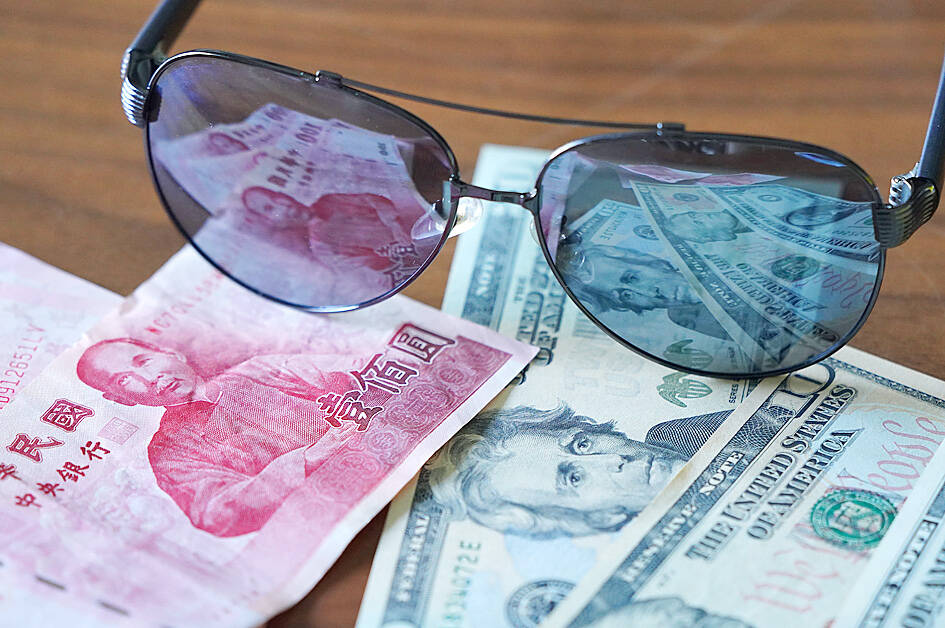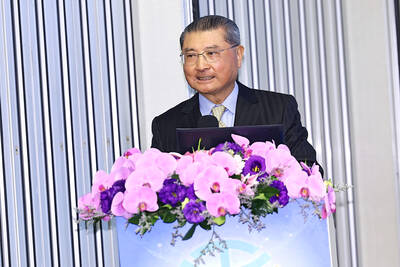The New Taiwan dollar might again underperform its Asian peers in any rally after the US Federal Reserve starts easing policy, given a considerable interest rate disadvantage and local firms’ stronger incentives to hold the US dollar.
The NT dollar rose 2.8 percent against the greenback last month, when the latter weakened globally after softer US data and shifting Fed rhetoric cemented expectations of a rate cut this month.
The gains pale before those of top regional performers such as the Malaysian ringgit and Indonesia’s rupiah, both of which jumped at least 5 percent. The NT dollar lost 0.25 percent to close at NT$32.021 per US dollar in Taipei yesterday.

Photo: CNA
Chief among the constraints for the NT dollar is a persistently wide yield discount to the US, which would maintain demand for the US dollar to fund carry trades seeking higher returns. A central bank wary of eroding export competitiveness and relaxed hedging rules for domestic life insurers, which are big foreign exchange users, might also slow local currency appreciation.
Furthermore, Taiwanese companies’ efforts to ramp up offshore investment in areas from the US to Southeast Asia, so as to trim their exposure to China, means their appetite for the US dollar would remain strong. Similarly, the upcoming US presidential election also poses uncertainties over relations across the Taiwan Strait, triggering more currency volatility.
“The Taiwan dollar could see some factors that may not impact other Asian currencies as much, such as the US election developments, tech sector developments, etc,” ING Bank NV chief economist for Greater China Lynn Song (宋林) said. “Until those uncertainties are resolved it may be reasonable to expect the lag to continue.”
Fundamentally, Taiwanese exporters’ low rate of currency conversion from the US dollar stems from the popularity of carry trades that finance purchases of higher-yielding foreign-currency assets by borrowing the NT dollar at lower interest rates.
Taiwanese companies’ rising structural demand for overseas investment is another factor, Bank of America Corp strategist Chun Him Cheung (張俊謙) said.
“Much of this increase in foreign investment is driven by derisking their manufacturing capacity away from mainland China,” Cheung said.
Bank of America recommends selling the NT dollar against the won through non-deliverable forwards to capitalize on the different currency dynamics between the two Asian rivals of tech exports.
The latest move by Taiwan’s financial regulator to reduce the burden of life insurers’ foreign-exchange hedging costs would also weigh on the local currency. Such hedging has been partly behind the recent rebound of the NT dollar.
Also generating caution is policy risk from any excessive gains in NT dollar, a hurdle for the local tech industry to maximize the benefits of the global frenzy about artificial intelligence.
Barclays Bank sees the US dollar-NT dollar pair, which was at NT$31.94 on Friday, have technical support at NT$31.5 to NT$31.8 in the near term, “as the central bank may step in to curb the pace of further TWD appreciation,” Barclays strategist Lemon Zhang (張蒙) said.
Goldman Sachs Group Inc foresees the exchange rate to rise toward NT$33 by late November.
To be sure, some analysts are more upbeat about the Taiwanese currency’s prospect, citing the likely benefits from inflows into emerging-market stocks in the aftermath of Fed rate cuts. The recent rallies in the yuan and yen might also spill over to Taiwan.
“Don’t think this round of Taiwan dollar appreciation is over yet,” BNP Paribas SA Greater China FX & rates strategist Ju Wang (王菊) said. “Lifers rule change will affect medium term, but the market needs to catch up with the yuan move.”
That said, the US presidential vote remains a big overhang.
Citigroup Inc flagged the NT dollar as a candidate for shorting against the US dollar going into November.
Taiwan’s currency looks “vulnerable” to tariff and election risks and also faces headwinds from an uncertain macroeconomic landscape, the bank wrote in a note on Thursday last week.

When an apartment comes up for rent in Germany’s big cities, hundreds of prospective tenants often queue down the street to view it, but the acute shortage of affordable housing is getting scant attention ahead of today’s snap general election. “Housing is one of the main problems for people, but nobody talks about it, nobody takes it seriously,” said Andreas Ibel, president of Build Europe, an association representing housing developers. Migration and the sluggish economy top the list of voters’ concerns, but analysts say housing policy fails to break through as returns on investment take time to register, making the

‘SILVER LINING’: Although the news caused TSMC to fall on the local market, an analyst said that as tariffs are not set to go into effect until April, there is still time for negotiations US President Donald Trump on Tuesday said that he would likely impose tariffs on semiconductor, automobile and pharmaceutical imports of about 25 percent, with an announcement coming as soon as April 2 in a move that would represent a dramatic widening of the US leader’s trade war. “I probably will tell you that on April 2, but it’ll be in the neighborhood of 25 percent,” Trump told reporters at his Mar-a-Lago club when asked about his plan for auto tariffs. Asked about similar levies on pharmaceutical drugs and semiconductors, the president said that “it’ll be 25 percent and higher, and it’ll

CHIP BOOM: Revenue for the semiconductor industry is set to reach US$1 trillion by 2032, opening up opportunities for the chip pacakging and testing company, it said ASE Technology Holding Co (日月光投控), the world’s largest provider of outsourced semiconductor assembly and test (OSAT) services, yesterday launched a new advanced manufacturing facility in Penang, Malaysia, aiming to meet growing demand for emerging technologies such as generative artificial intelligence (AI) applications. The US$300 million facility is a critical step in expanding ASE’s global footprint, offering an alternative for customers from the US, Europe, Japan, South Korea and China to assemble and test chips outside of Taiwan amid efforts to diversify supply chains. The plant, the company’s fifth in Malaysia, is part of a strategic expansion plan that would more than triple

Taiwanese artificial intelligence (AI) server makers are expected to make major investments in Texas in May after US President Donald Trump’s first 100 days in office and amid his rising tariff threats, Taiwan Electrical and Electronic Manufacturers’ Association (TEEMA, 台灣電子電機公會) chairman Richard Lee (李詩欽) said yesterday. The association led a delegation of seven AI server manufacturers to Washington, as well as the US states of California, Texas and New Mexico, to discuss land and tax issues, as Taiwanese firms speed up their production plans in the US with many of them seeing Texas as their top option for investment, Lee said. The